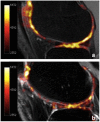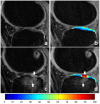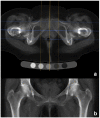Advanced Imaging in Osteoarthritis
- PMID: 27510507
- PMCID: PMC5010138
- DOI: 10.1177/1941738116663922
Advanced Imaging in Osteoarthritis
Abstract
Context: Radiography is widely accepted as the gold standard for diagnosing osteoarthritis (OA), but it has limitations when assessing early stage OA and monitoring progression. While there are improvements in the treatment of OA, the challenge is early recognition.
Evidence acquisition: MEDLINE and PubMed as well as professional orthopaedic and imaging websites were reviewed from 2006 to 2016.
Study design: Clinical review.
Level of evidence: Level 4.
Results: Magnetic resonance imaging (MRI) can provide the most comprehensive assessment of joint injury and OA with the advantages of being noninvasive and multiplanar with excellent soft tissue contrast. However, MRI is expensive, time consuming, and not widely used for monitoring OA clinically. Computed tomography (CT) and CT arthrography (CTA) can also be used to evaluate OA, but these are also invasive and require radiation exposure. Ultrasound is particularly useful for evaluation of synovitis but not for progression of OA.
Conclusion: MRI, CT, and CTA are available for the diagnosis and monitoring of OA. Improvement in techniques and decrease in cost can allow some of these modalities to be effective methods of detecting early OA.
Keywords: CT; MRI; cartilage; osteoarthritis; ultrasound.
© 2016 The Author(s).
Conflict of interest statement
The author(s) reported no potential conflicts of interest in the development and publication of this manuscript.
Figures








References
-
- Akella SV, Regatte RR, Gougoutas AJ, et al. Proteoglycan-induced changes in T1ρ-relaxation of articular cartilage at 4T. Magn Reson Med. 2001;46:419-423. - PubMed
-
- Anandacoomarasamy A, Leibman S, Smith G, et al. Weight loss in obese people has structure-modifying effects on medial but not on lateral knee articular cartilage. Ann Rheum Dis. 2012;71:26-32. - PubMed
-
- Apprich S, Trattnig S, Welsch GH, et al. Assessment of articular cartilage repair tissue after matrix-associated autologous chondrocyte transplantation or the microfracture technique in the ankle joint using diffusion-weighted imaging at 3 Tesla. Osteoarthritis Cartilage. 2012;20:703-711. - PubMed
Publication types
MeSH terms
LinkOut - more resources
Full Text Sources
Other Literature Sources
Medical
Research Materials

